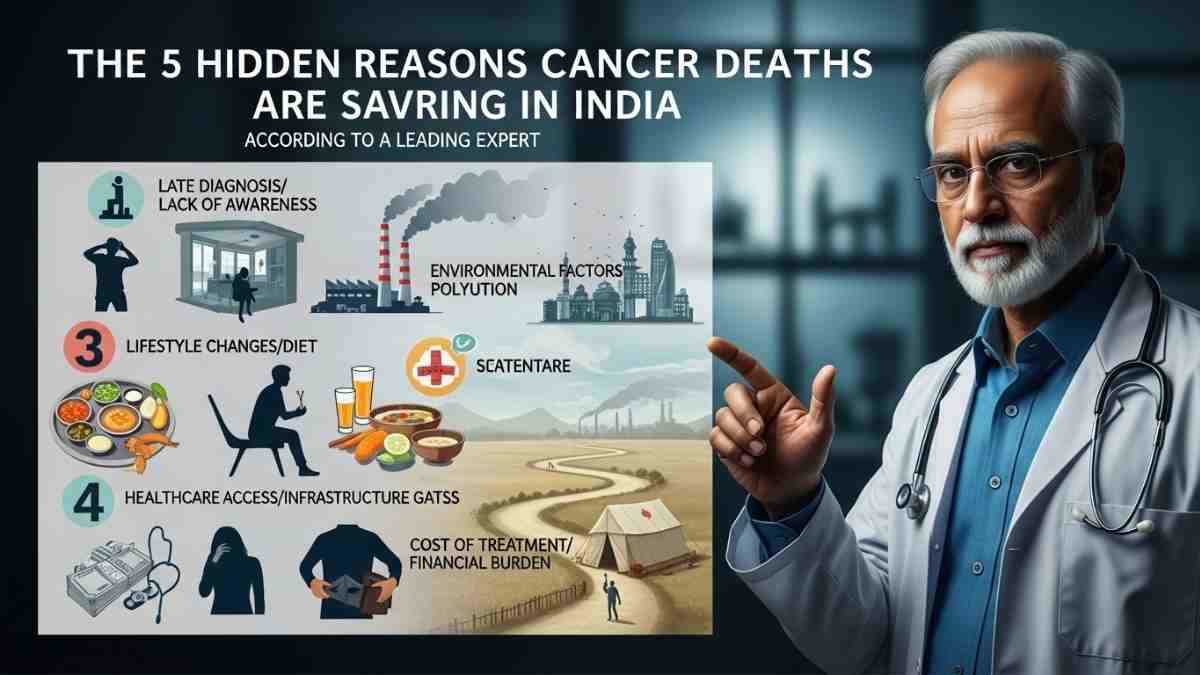A Silent Crisis: Top Oncologist Reveals the 5 Devastating Reasons Behind India’s High Cancer Mortality Rate
Cancer. The very word evokes a primal sense of fear, a specter of long, painful battles and uncertain outcomes. In India, this battle is being waged on an epic scale, but despite significant advances in medical science, a grim reality persists: the cancer mortality rate in India remains heartbreakingly high. Many lives that could potentially be saved are lost, not always to the disease itself, but to a complex web of social, economic, and systemic failures.
A leading oncologist has stepped forward to shed light on this silent epidemic, pinpointing five major reasons for cancer deaths in India that go far beyond the biology of the disease. This expert analysis is a crucial wake-up call, revealing a crisis that is as much about awareness and access as it is about medicine.
Reason 1: The Catastrophic Delay – Late-Stage Diagnosis
This is, by far, the most critical and tragic factor. In India, an overwhelming majority of cancer patients—some estimates suggest up to 70-80%—are diagnosed at an advanced stage (Stage III or IV). At this point, the cancer has often spread (metastasized), making treatment far more complex, less effective, and often palliative rather than curative.
-
Why the Delay? This isn’t just negligence; it’s a systemic issue rooted in:
-
Lack of Awareness: A fundamental lack of public awareness about the early symptoms of cancer (like a persistent cough, unexplained weight loss, a non-healing ulcer, or a lump) means people often ignore warning signs, dismissing them as minor ailments.
-
Fear and Stigma: The social stigma surrounding cancer can lead to denial and a reluctance to seek medical help.
-
Inadequate Primary Healthcare: At the primary care level, general practitioners may not always be equipped to recognize early cancer symptoms, leading to misdiagnosis or delayed referrals to specialists.
-
This catastrophic delay is the single biggest hurdle in the fight against cancer. Early detection of cancer is the most powerful weapon we have, and in India, it is tragically underutilized.
Reason 2: The Crippling Cost of Care – Financial Toxicity
Cancer treatment is exorbitantly expensive. The concept of “financial toxicity”—where the cost of treatment becomes so burdensome that it destroys a family’s financial well-being—is a harsh reality for millions.
-
The Burden: A single cycle of chemotherapy or a course of targeted therapy can cost lakhs of rupees. For the majority of the Indian population, which lacks comprehensive health insurance, this cost is simply unbearable.
-
The Tragic Choice: This leads to heartbreaking scenarios where families are forced to abandon treatment midway, sell their assets, or forgo recommended therapies in favor of cheaper, less effective alternatives. This financial barrier is a direct contributor to poor treatment outcomes and high mortality rates.
Reason 3: Treatment Abandonment and Non-Compliance
Closely linked to financial toxicity is the issue of treatment abandonment. A cancer treatment regimen is a long, arduous journey that requires unwavering compliance. However, many patients in India drop out of treatment before it is completed.
-
The Causes:
-
Financial Exhaustion: As explained above, many simply run out of money.
-
Geographical Barriers: Specialized cancer treatment centers in India are largely concentrated in major cities. Patients from rural areas face immense logistical challenges, including travel, accommodation, and loss of daily wages, making it difficult to continue a months-long treatment cycle.
-
Hope in Quackery: In a desperate search for a “miracle cure,” some patients abandon evidence-based medicine in favor of unproven alternative therapies, losing precious time and allowing the disease to progress unchecked.
-
4. Unequal Access to Quality Cancer Care
There is a vast and disturbing disparity in the quality and availability of cancer care across India. The advanced, state-of-the-art treatment available in a metropolitan corporate hospital is a world away from the overburdened and under-resourced facilities in a smaller town or rural area.
-
The Urban-Rural Divide: This “postcode lottery” means that a person’s chances of survival are significantly influenced by where they live. Access to crucial resources like advanced diagnostics (PET scans), radiation therapy, specialized oncologists, and surgical experts is highly unequal.
5. The Tobacco and Lifestyle Epidemic
Finally, a significant portion of cancer cases in India are directly linked to preventable lifestyle factors, with tobacco use being the biggest culprit.
-
The Burden of Preventable Cancers: Cancers of the head and neck, lungs, and oral cavity, which are overwhelmingly caused by smoking and the use of smokeless tobacco (like gutka and pan masala), constitute a huge proportion of the cancer burden in India.
-
Changing Lifestyles: In addition, lifestyle changes associated with urbanization—such as poor diet, lack of physical activity, and rising obesity rates—are leading to an increase in cancers of the breast, colon, and uterus.
A Call for Collective Action: The Path Forward
This oncologist’s analysis is a sobering reminder that winning the war against cancer requires more than just medical breakthroughs. It demands a massive, multi-pronged effort focused on:
-
Aggressive Public Awareness Campaigns on early cancer symptoms.
-
Strengthening Primary Healthcare for better screening and early detection.
-
Making Cancer Treatment More Affordable through better government health schemes and wider insurance penetration.
-
Improving Cancer Care Infrastructure in tier-2 and tier-3 cities.
-
Doubling Down on Anti-Tobacco and Healthy Lifestyle Initiatives.
The battle is daunting, but by addressing these five fundamental challenges, countless lives can be saved, turning stories of despair into stories of survival and hope.
Updated on August 20, 2025 with latest context.



